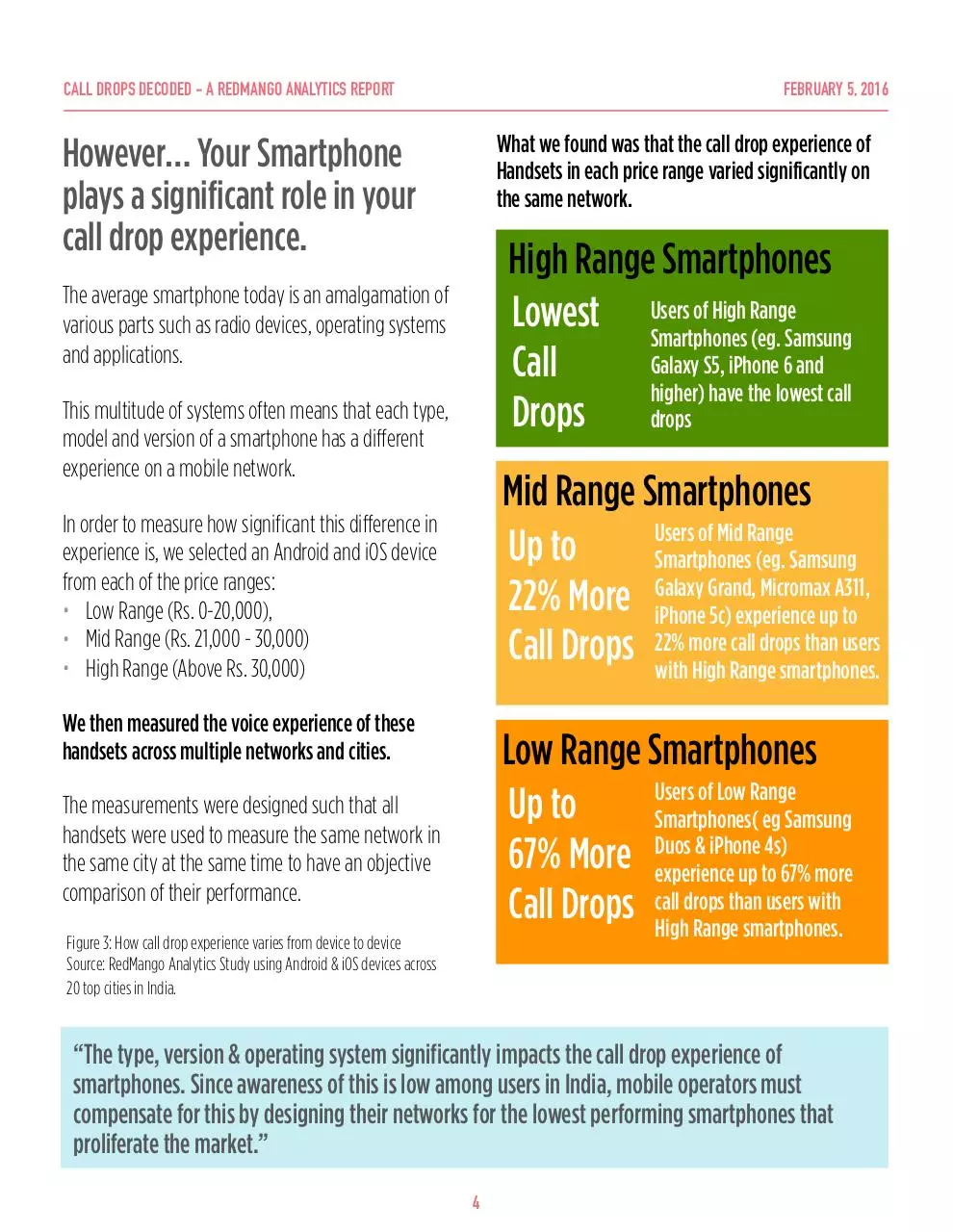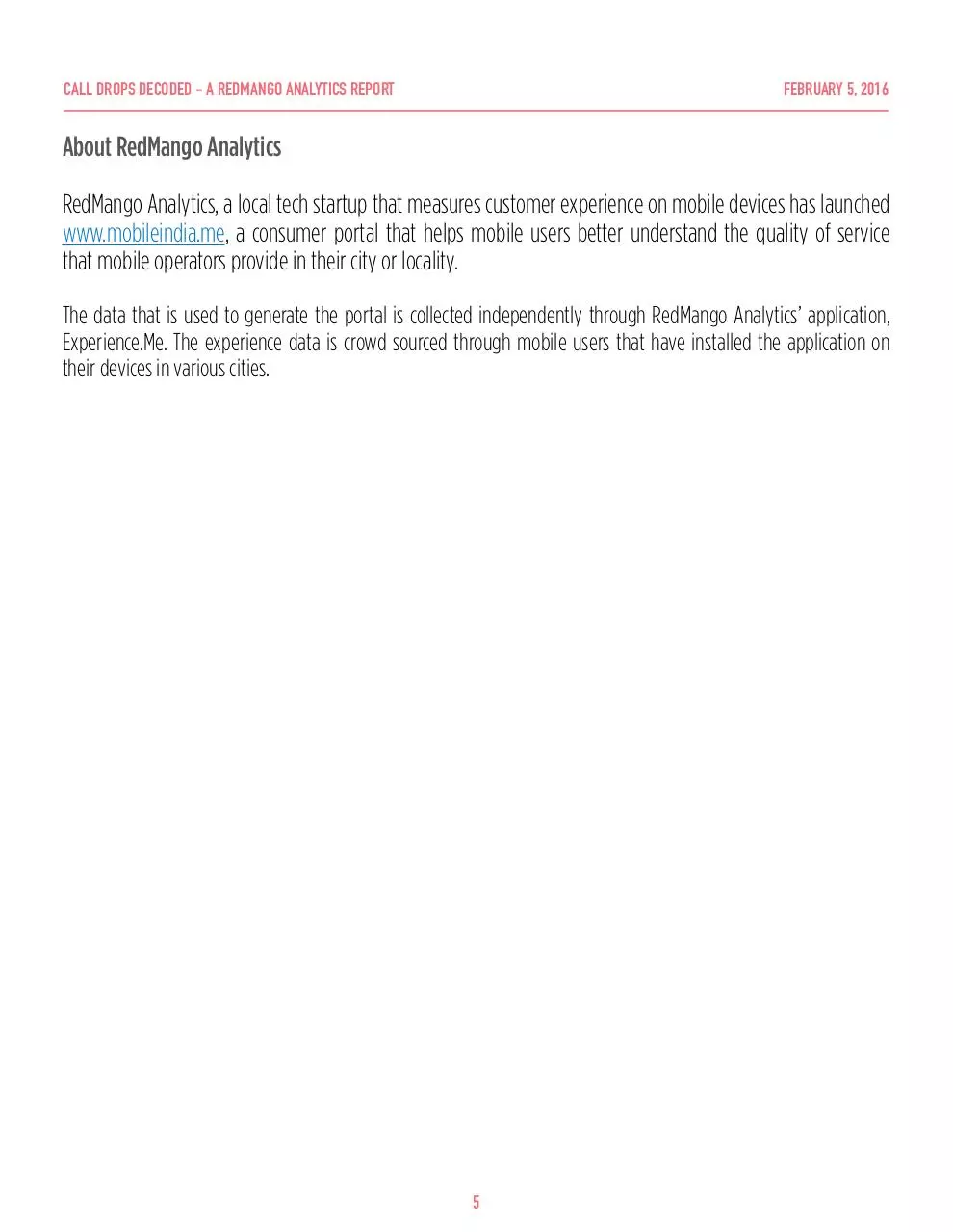Call Drops Report by RedMango Analytics (PDF)
File information
Title: Hindu Businessline Article
This PDF 1.3 document has been generated by Pages / Mac OS X 10.11 Quartz PDFContext, and has been sent on pdf-archive.com on 10/03/2016 at 13:57, from IP address 219.91.x.x.
The current document download page has been viewed 1155 times.
File size: 233.23 KB (5 pages).
Privacy: public file





File preview
A REDMANGO ANALYTICS PVT. LTD. REPORT
FEBRUARY 5, 2016
Call Drops Decoded
Why Call Drops happen - And how the smartphone you choose may make the problem worse
A Call Drop is
when an ongoing call is
suddenly interrupted
against the wishes of the
user.
4.73%
We Measured Call drops on different phones across
over 20 cities in India
CALL DROPS IN INDIA ARE HIGHER THAN THE GLOBALLY ACCEPTED 3% STANDARD.
Call Drop rates in
India
averaged around 4.73%
according to a RedMango
study of 20 Cities in 2015.
(www.mobileindia.me)
There are 3 major reasons why mobile networks drop calls.
1
2
3
POOR COVERAGE
POOR QUALITY
NETWORK FAILURES
A call may drop when the
phone or tower does not
receive the radio signal
with enough strength to
hold the call.
A call may drop when
there is a lot of
interference in the
connection between the
phone & the tower
A call may also drop due
to various network issues
such as congestion or a
failed Handover between
two towers
Figure 1: Why Calls Drop Source - RedMango Analytics Study across 20 cities in India
1
TRAI prescribes 2%
As the acceptable call
drop rate for the country.
CALL DROPS DECODED - A REDMANGO ANALYTICS REPORT
FEBRUARY 5, 2016
1. Poor Coverage
2. Poor Quality
Reception of the Signal from the tower to the mobile
or vice versa may result in a call being dropped.
High amount of Interference in the radio signal from
the mobile phone to the tower and vice versa may
cause calls to drop.
There are various factors that can contribute to the
signal not being received with enough power to be
able to sustain a conversation.
Chances are fairly high that you have experienced a
call with voice quality issues. Some of the issues you
may have faced include cracking voice, audible noise in
the call, inability of one side to hear the other, blank
speech, voice echo etc.
The primary reason for this is a lack of mobile towers.
However another reason may also be due to what is
known as the cell breathing effect.
Most of these are caused by radio interference.
Interference in the signal can occur due to several
reasons. The leading causes of interference are:
Imagine a room packed with people trying to have a
conversation. The more people there are talking, the
harder it is to hear your conversation and as a result
everyone needs to speak louder. With UMTS (3G) and
LTE (4G) FDD technology, mobile towers work with a
similar concept. Due to many users transmitting at the
same time, a tower needs to receive the signal from
each phone with a higher power level to decipher it.
This creates a virtual shrinking of the area covered by
that tower whereby the mobile phones at the edge of
the area are unable to sustain a call.
• Signal Noise from neighboring towers - This
happens when the network is not optimized
properly and signals from neighboring towers
infiltrate the coverage area of the serving tower
• Inefficient use of spectrum - In case spectrum is
not reused efficiently, this can cause a virtual
scarcity of spectrum for a particular service
resulting in interference issues. For eg. If Operators
allocate a large amount of spectrum for data
services while neglecting voice, call quality suffers.
• High congestion due to lack of spectrum - In a
country like India, where there are a vast number of
mobile users, multiple mobile operators and a finite
amount of spectrum resources, networks
inadvertently have to support a large number of
users on limited spectrum. This causes congestion,
and subsequently, interference.
Most operators account for this effect while planning
their networks, but sudden high loads, poor planning
or lack of towers magnify this problem resulting in
higher call drops.
2
CALL DROPS DECODED - A REDMANGO ANALYTICS REPORT
FEBRUARY 5, 2016
WHILE THE THREE CAUSES LISTED ARE THE REASONS
WHY CALLS DROP, NOT ALL REASONS ARE EQUALLY
RESPONSIBLE FOR THE CALL DROP PROBLEM IN INDIA.
3. Network Failures
Calls may also be dropped due to various faults in the
network.
Calls Drop mainly due to poor Quality and Network
Faults.
Apart from Coverage and Quality, another leading
factor of dropped calls are network faults.
Network failures occur mainly due to incorrect
definition of network parameters causing some parts
of the network to behave incorrectly.
They also occur due to faulty network hardware.
Network faults are often the most unpredictable. You
may have experienced a dropped call due to a network
fault when the call suddenly dropped while everything
was fine.
Calls also tend to drop more when you are on the
move. As you move from the coverage area of one cell
tower to another, the conversation “hands off” to the
nearest tower with the best signal. Sometimes this
handoff fails to happen and your call drops.
Figure 2: Reasons for Call Drops
Source: RedMango Analytics study of over 10,000 calls across 20
top cities in India
ONLY 4% OF ALL THE DROPPED CALLS WERE IN POOR COVERAGE AREAS.
This indicates that while the lack of mobile towers results in call drops, it is not the leading factor that
contributes to the problem.
59.1% OF ALL THE DROPPED CALLS WERE DUE TO POOR QUALITY.
Most call drops occur due to interference and other quality related issues. While lack of spectrum and high
user concentration may be to blame for some of these problems, Network optimization can result in a
significant reduction in call drop problems.
36.9% OF ALL THE DROPPED CALLS WERE DUE TO NETWORK FAULTS.
A significant number of call drops also occur due to network infrastructure problems.
3
CALL DROPS DECODED - A REDMANGO ANALYTICS REPORT
FEBRUARY 5, 2016
However… Your Smartphone
plays a significant role in your
call drop experience.
What we found was that the call drop experience of
Handsets in each price range varied significantly on
the same network.
High Range Smartphones
of High Range
Lowest Users
Smartphones (eg. Samsung
Galaxy S5, iPhone 6 and
Call
higher) have the lowest call
Drops
drops
The average smartphone today is an amalgamation of
various parts such as radio devices, operating systems
and applications.
This multitude of systems often means that each type,
model and version of a smartphone has a different
experience on a mobile network.
Mid Range Smartphones
Users of Mid Range
Up to
Smartphones (eg. Samsung
Grand, Micromax A311,
22% More Galaxy
iPhone 5c) experience up to
more call drops than users
Call Drops 22%
with High Range smartphones.
In order to measure how significant this difference in
experience is, we selected an Android and iOS device
from each of the price ranges:
• Low Range (Rs. 0-20,000),
• Mid Range (Rs. 21,000 - 30,000)
• High Range (Above Rs. 30,000)
We then measured the voice experience of these
handsets across multiple networks and cities.
Low Range Smartphones
Users of Low Range
Up to
Smartphones( eg Samsung
& iPhone 4s)
67% More Duos
experience up to 67% more
drops than users with
Call Drops call
High Range smartphones.
The measurements were designed such that all
handsets were used to measure the same network in
the same city at the same time to have an objective
comparison of their performance.
Figure 3: How call drop experience varies from device to device
Source: RedMango Analytics Study using Android & iOS devices across
20 top cities in India.
“The type, version & operating system significantly impacts the call drop experience of
smartphones. Since awareness of this is low among users in India, mobile operators must
compensate for this by designing their networks for the lowest performing smartphones that
proliferate the market.”
4
CALL DROPS DECODED - A REDMANGO ANALYTICS REPORT
FEBRUARY 5, 2016
About RedMango Analytics
RedMango Analytics, a local tech startup that measures customer experience on mobile devices has launched
www.mobileindia.me, a consumer portal that helps mobile users better understand the quality of service
that mobile operators provide in their city or locality.
The data that is used to generate the portal is collected independently through RedMango Analytics’ application,
Experience.Me. The experience data is crowd sourced through mobile users that have installed the application on
their devices in various cities.
5
Download Call Drops Report by RedMango Analytics
Call Drops Report by RedMango Analytics.pdf (PDF, 233.23 KB)
Download PDF
Share this file on social networks
Link to this page
Permanent link
Use the permanent link to the download page to share your document on Facebook, Twitter, LinkedIn, or directly with a contact by e-Mail, Messenger, Whatsapp, Line..
Short link
Use the short link to share your document on Twitter or by text message (SMS)
HTML Code
Copy the following HTML code to share your document on a Website or Blog
QR Code to this page

This file has been shared publicly by a user of PDF Archive.
Document ID: 0000348589.